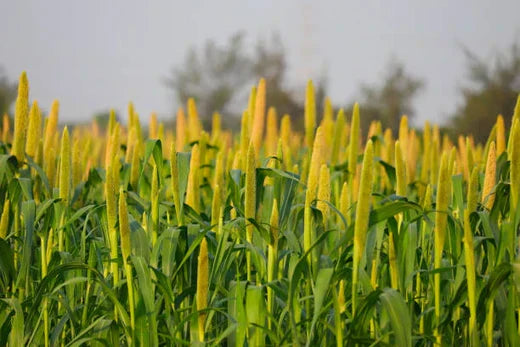
What are 5 positive millets? Understanding its Nutrition & Benefits
Share
Understanding Positive Millets
Did you know that before rice and wheat became the commonly eaten source of carbohydrate across the world, thousands of years ago, millets were among the first crops domesticated by humans? These super grains, full of essential nutrients, are making a modern day comeback and being recognised as “positive millets”. Not only are these millets a good source of nutrients, they are also environmentally sustainable owing to their ability to grow in arid environments. Not just a health trend, these grains are a global effort to combat food insecurity and promote eco-friendly diets. Let’s learn more about them.
What Are Positive Millets?
Positive millets are a category of millet grains with dietary fiber between 8%-12.5%, popularized for their high nutritional profile and environmental benefits. They include foxtail millet, little millet, barnyard millet, kodo millet and browntop millet.
What Sets Positive Millets Apart?
- Nutritional Superiority: Millets are rich in essential nutrients, crude fiber, protein, and micronutrients like calcium and iron. This makes them a good source of carbohydrates and protein, together in a single food group.
- Environmental Friendliness: Millets thrive in harsh conditions with minimal water and fertilizers, making them a sustainable choice for agriculture.
- Versatility in Use: Positive millets can be incorporated into a variety of recipes, from traditional dishes like idlis, dosas, and khichdi to foods like pasta, cakes, and cookies.
- Chronic Disease Management: Their low glycemic index, antioxidant properties, and high fiber content make them ideal for managing lifestyle diseases like diabetes, obesity, and cardiovascular issues.
Different Types of Positive Millets
Some of the positive millets include:
1. Foxtail Millet
- Foxtail millet is also known as kangni in Hindi, korralu in Telugu, and Thinai in Tamil.
- It is rich in protein, iron, and dietary fiber and is great for managing blood sugar levels and supporting heart health.
- It has around 11.2 gm of protein for every 100 gms of the millet and 14 mg of calcium.
2. Little Millet
- Little millet is called kutki in Hindi, samai in Tamil, and samalu in Telugu.
- It is a gluten-free grain with a mildly sweet flavor, and is ideal for weight management and gut health.
- 100 gms of little millet has about 10.3 gms of protein, and 32 mg of calcium.

Also Read: Benefits of Little Millet
3. Barnyard Millet
- Barnyard millet is called samwa in Hindi, odalu in Telugu, and kuthravali in Tamil.
- Known for its high fiber content, barnyard millet aids digestion and helps in detoxifying the body.
- 100 gms of barnyard millet has around 7.7 gms of protein, and 17 mg of calcium.
4. Kodo Millet
- Kodo millet is called kodon in Hindi, arikelu in Telugu, and varagu in Tamil.
- Kodo millet is a great choice for those with gluten sensitivity and celiac disease, and supports muscle repair and has a low glycemic index.
- 100 gms of kodo millet has around 7.7 gms of protein, and 17 mg of calcium.
5. Browntop Millet
- Browntop millet is called hari kangni in Hindi, kula samai in Telugu, and anda korra in Tamil.
- This rare variety of millet is packed with antioxidants, this rare millet promotes better immunity and bone health.
- 100 gms of browntop millet has around 9 gms of protein, and 28 mg of calcium.
Health Benefits of Positive Millets
- Rich in Nutrients: Millets are packed with B-group vitamins like niacin,thiamin, riboflavin, etc., minerals, and antioxidants like polyphenols that support overall health.For a heart-healthy snack, try our Millet Murukku
- Gluten-Free: All the millets in their natural form are gluten-free which is a main reason for the growing popularity of these grains as it suits those with gluten sensitivity and celiac disease.
- Supports Weight Management: Millets’ high fiber give a feeling of fullness thus making you eat less, in turn aiding in weight control.
- Improves Digestive Health: Due to the fibre content, millets help maintain a healthy gut and help with digestive issues like bloating, and prevent constipation.
- Regulates Blood Sugar Levels: Their low glycemic index makes them suitable for those with diabetes.
- Boosts Heart Health: High magnesium and potassium content in the millets are good for cardiovascular function.
- Enhances Immunity: Rich in antioxidants like polyphenols, millets help in free radicals from the environment that cause oxidative stress.
- Sustainable and Environment-Friendly: Millets require less water and resources, promoting sustainable agriculture.
FAQs
FAQ 1: What are positive millets and why are they important?
Positive millets are nutrient-rich grains like foxtail, little, and kodo millet. They are valued for their high nutritional content, gluten-free nature, and ability to support sustainable agriculture.
FAQ 2: How do positive millets benefit health?
They improve digestion, regulate blood sugar, strengthen bones, and boost immunity thanks to their fiber, minerals, and antioxidant properties.
FAQ 3: Can positive millets help in weight management?
Yes, their high fiber and complex carbohydrates promote satiety and sustained energy, making them ideal for weight loss.
All in all making the positive millets part of one’s daily diet is a great step towards a healthy journey. Due to their versatility they can be used to make a range of regular Indian breakfast, lunch and dinner recipes. Packed with nutrients and versatility, these ancient grains cater to modern dietary needs without compromising on taste or eco-conscious values. So, why not let these time-tested superfoods redefine your meals and your mindset?
Liked this article? Follow our other blogs for awesome and healthy millet recipes and benefits!
Check out our range of gluten free, healthy millet delights here.
